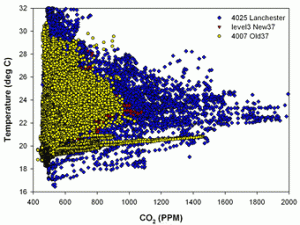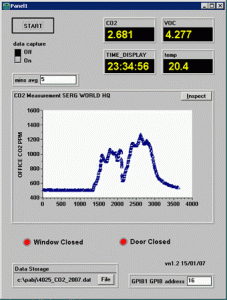The carbon dioxide concentration levels normally observed in indoor environments range from 350 to 2,500 ppm and are typically between 500 and 1,500 ppm. Current literature suggests that a building’s carbon dioxide concentration can be seen as an indicator for both volatile organic component (VOC) concentration and general indoor air quality. However, the potential to use CO2 concentration as a measure of a building’s ventilation rate is limited as concentration levels depend on both the quality and the rate of air supply. Nevertheless, indoor CO2 levels are considered as one of the main drivers for ventilation requirements.

Fig. 1. Correlation of office room temperatures and CO2 levels measured in three different offices over a 4 month period from March to June 2006.
Researchers of the Sustainable Energy Research Group have been observing the relationship between indoor carbon dioxide concentration and ambient temperatures in typical office environments. Long term data logging within both, naturally ventilated and mixed mode buildings, has shown that ‘optimum’ indoor air temperatures typically associated with highest thermal comfort and user satisfaction levels are often coupled with the highest observed CO2 concentrations (Figure 1).
This dependency is strongest for spaces which enable high air exchange rates by individual user interaction with the façade. For indoor air temperatures outside the optimum (below or above) the CO2 concentration appeared to be generally lower.

Fig. 2. Control screen of the continuous CO2 monitoring inside a multi-occupancy office at the University of Southampton.
A relationship between maximum observed CO2 concentration and indoor air temperature was identified, varying in magnitude depending on the ventilation scheme (natural ventilation, mixed mode).
Initial findings suggest that within the optimum temperature range the building occupants’ ventilation driver response is slow resulting in high CO2 concentrations. However, for temperatures lower than the optimum the CO2 concentration appears to be increasingly important for ventilation behaviour. Conversely, temperature becomes the dominant driver for ventilation when the optimum temperature range has been exceeded. The initial study, an example of which is shown in Figure 3, highlights that building users may well be prepared to accept higher indoor CO2 levels of 800 ppm or more, provided that the temperature conditions are as desired.
To further investigate this issue a multi-occupancy office room at the University of Southampton has been equipped with a continuous CO2 monitoring as well as window and door actuators to monitor the occupants’ ventilation behaviour (Figure 2).
